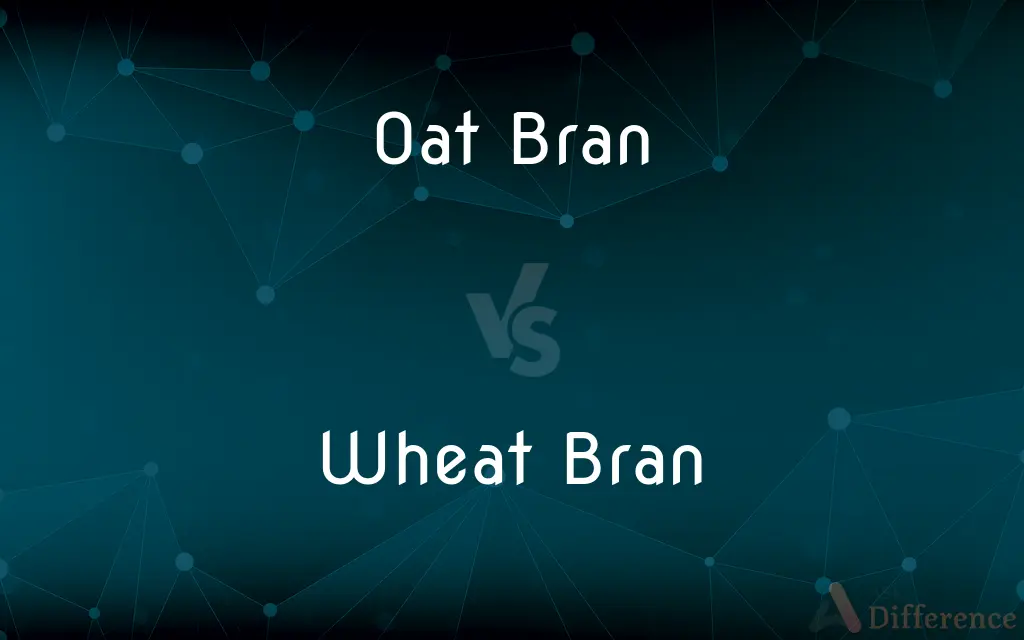Oat Bran vs. Wheat Bran — What's the Difference?
By Urooj Arif & Fiza Rafique — Published on May 3, 2024
Oat bran is derived from the outer layer of oat grains and is known for its soluble fiber, beneficial for heart health, while wheat bran, from the outer layer of wheat grains, is rich in insoluble fiber, aiding in digestion.

Difference Between Oat Bran and Wheat Bran
Table of Contents
ADVERTISEMENT
Key Differences
Oat Bran comes from the outer husk of the oat grain, which is removed during the milling process. It is particularly noted for its high content of soluble fiber, specifically beta-glucan, which has been shown to lower LDL cholesterol levels and improve heart health. Oat bran also has a softer texture and a slightly sweet taste, making it a popular addition to breakfast cereals, baked goods, and smoothies. It provides a good source of protein, iron, and B vitamins, contributing to a balanced diet.
Wheat Bran, the outer layer of the wheat kernel, is mostly composed of insoluble fiber, which does not dissolve in water. This type of fiber is excellent for promoting regular bowel movements and preventing constipation. Wheat bran has a coarser texture and a nuttier flavor compared to oat bran, and it's often used in baking to add fiber and texture to bread, muffins, and cereal. Beyond fiber, wheat bran offers significant amounts of magnesium, phosphorus, and other minerals.
Both oat and wheat bran are beneficial for digestive health, but their differences in fiber types mean they offer unique health benefits. Oat bran's soluble fiber can help reduce cholesterol and regulate sugar levels, making it particularly beneficial for heart health and diabetic diets. Wheat bran's insoluble fiber, on the other hand, is more focused on improving digestive health and regularity.
In terms of culinary uses, oat bran can easily be incorporated into a softer, more palatable texture, suitable for a wide range of dishes. Wheat bran, with its coarser texture, is better suited for adding crunch and fiber to baked goods. Both can be included in a healthy diet to enhance nutritional intake, but their selection might depend on specific health goals or dietary preferences.
Comparison Chart
Type of Fiber
High in soluble fiber (beta-glucan).
High in insoluble fiber.
ADVERTISEMENT
Health Benefits
Lowers LDL cholesterol, improves heart health, regulates blood sugar.
Promotes bowel regularity, prevents constipation.
Texture
Softer, can be creamy when cooked.
Coarser, adds crunch to foods.
Taste
Slightly sweet.
Nuttier flavor.
Nutritional Highlights
Good source of protein, iron, B vitamins.
Rich in magnesium, phosphorus, and other minerals.
Culinary Uses
Breakfast cereals, smoothies, baked goods.
Adds fiber and texture to bread, muffins, cereal.
Compare with Definitions
Oat Bran
Known for its cholesterol-lowering effects.
Daily oat bran consumption has helped lower my LDL cholesterol.
Wheat Bran
Aids in preventing constipation.
Incorporating wheat bran into my diet has alleviated constipation.
Oat Bran
The outer husk of oats, rich in soluble fiber.
Adding oat bran to your morning smoothie can boost heart health.
Wheat Bran
Commonly used to add fiber to baked goods.
I sprinkle wheat bran on my cereal for extra fiber.
Oat Bran
Slightly sweet and soft texture.
Oat bran makes a creamy addition to breakfast cereals.
Wheat Bran
The outer layer of the wheat kernel, high in insoluble fiber.
Wheat bran is my go-to for promoting digestive regularity.
Oat Bran
Versatile in cooking and baking.
I use oat bran to increase the nutritional content of homemade bread.
Wheat Bran
Coarser texture and nuttier flavor.
Wheat bran adds a nice crunch to my morning muffins.
Oat Bran
Beneficial for blood sugar regulation.
Oat bran has been a great dietary addition for managing my diabetes.
Wheat Bran
Rich in minerals like magnesium and phosphorus.
Wheat bran is a good source of minerals essential for bone health.
Common Curiosities
Can wheat bran help with weight loss?
Yes, its high fiber content can promote a feeling of fullness, potentially aiding in weight loss.
Which bran is better for digestive health?
Both are beneficial, but wheat bran is specifically known for improving bowel regularity due to its insoluble fiber.
Which is better for lowering cholesterol, oat bran or wheat bran?
Oat bran is better for lowering cholesterol due to its high soluble fiber content.
Can consuming too much bran be harmful?
Excessive fiber intake can lead to digestive discomfort, so it's important to increase fiber gradually and maintain adequate hydration.
What are the main nutritional differences between oat bran and wheat bran?
Oat bran is higher in soluble fiber and protein, while wheat bran offers more insoluble fiber and minerals.
How can I incorporate oat bran into my diet?
Oat bran can be added to smoothies, cereals, and baked goods, or cooked into a porridge.
How does the fiber in oat bran and wheat bran affect heart health?
Oat bran's soluble fiber can lower bad LDL cholesterol, reducing heart disease risk. Wheat bran's fiber doesn't directly lower cholesterol but supports overall digestive health.
Are oat bran and wheat bran gluten-free?
Oat bran is naturally gluten-free but may be cross-contaminated during processing, while wheat bran contains gluten.
Can I substitute oat bran for wheat bran in recipes?
Yes, but expect a difference in texture and moisture, as oat bran is finer and absorbs more liquid.
Is there a taste difference between oat bran and wheat bran?
Yes, oat bran is slightly sweet, while wheat bran has a nuttier flavor.
Can incorporating bran into my diet improve my skin health?
A diet high in fiber, like those including oat and wheat bran, can improve digestion and detoxification, potentially leading to better skin health due to the removal of toxins.
Is oat bran suitable for a low-carb diet?
While oat bran is lower in carbs than whole oat grains, it still contains a significant amount, so it should be consumed in moderation on a low-carb diet.
Do oat bran and wheat bran contain antioxidants?
Yes, both oat bran and wheat bran contain antioxidants, with oat bran providing avenanthramides and wheat bran offering phenolic acids, which combat oxidative stress.
Can oat bran and wheat bran be used in gluten-free diets?
Oat bran can be used in gluten-free diets if certified as gluten-free. Wheat bran contains gluten and is not suitable for those with celiac disease or gluten sensitivity.
Which is more calorie-dense, oat bran or wheat bran?
Oat bran is slightly more calorie-dense due to its higher fat content, but both are low in calories relative to their volume and nutrient density.
How does wheat bran's insoluble fiber benefit long-term health?
Insoluble fiber in wheat bran helps prevent constipation, reducing the risk of digestive disorders like diverticulitis and hemorrhoids over time.
Are there any risks associated with consuming too much bran?
Consuming too much bran quickly can lead to digestive issues like bloating and gas. It's important to increase fiber intake gradually and ensure adequate hydration.
Share Your Discovery

Previous Comparison
Edge vs. 3G
Next Comparison
Hydropower vs. Solar PowerAuthor Spotlight
Written by
Urooj ArifUrooj is a skilled content writer at Ask Difference, known for her exceptional ability to simplify complex topics into engaging and informative content. With a passion for research and a flair for clear, concise writing, she consistently delivers articles that resonate with our diverse audience.
Co-written by
Fiza RafiqueFiza Rafique is a skilled content writer at AskDifference.com, where she meticulously refines and enhances written pieces. Drawing from her vast editorial expertise, Fiza ensures clarity, accuracy, and precision in every article. Passionate about language, she continually seeks to elevate the quality of content for readers worldwide.













































